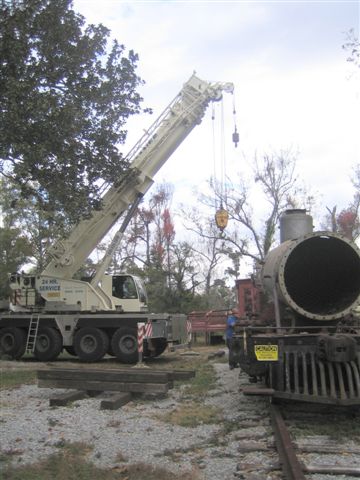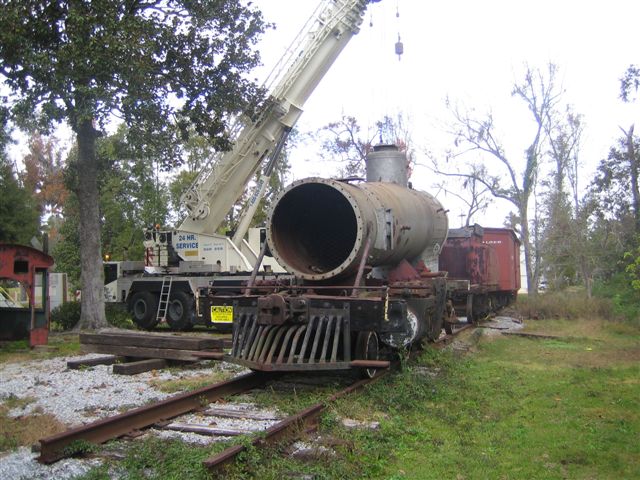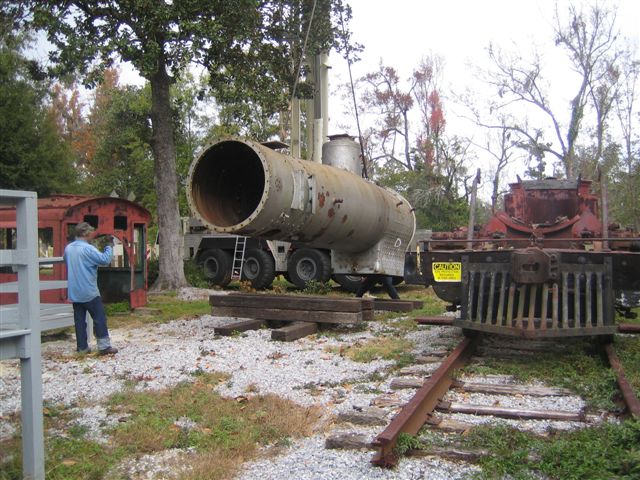Restoration Works Begins On Old 100 Steam Engine
November 12, 2008
A shiny coat of paint and more is in store for Century’s Old 100.
After over a year with no obvious changes, the Alger-Sullivan Historical Society contracted Mr. Denvard Moss of Birmingham to begin work on the restoration of the steam engine Old 100. Deep South Cranes of Pensacola made a trip to the historical park in Century to move some components of the engine so work might begin in earnest.
It turns out that the men operating the crane were a couple of North Escambia and Santa Rosa County fellows, Curtis Fillingim of Walnut Hill and Bryan Watson of Jay. Both men have some pretty solid connections with this part of the counties, having lots of relatives living in the area.
Because of the estimated weight of the boiler and tight place the crane had to operate, Deep South had to send their largest piece of equipment to make the moves. In preparation for the shifting around of the boiler, estimated to weigh in at over ten tons, and the tender’s water tank, a mere 2 tons, Moss had to manhandle several railroad crossties in position to rest the parts.
For more photos from Old 100, click here.
 Moss, who has restored many steam engines across the southeast, is presently dividing his time between the historical former T.R. Miller locomotive now at the historical village just off Tarragona Street in Pensacola, and another engine in Cummings, GA. He comes highly recommended to the ASHS by Louis Zadnichek, a former scrap metal broker residing in Fairhope, and a former owner of Old 100.
Moss, who has restored many steam engines across the southeast, is presently dividing his time between the historical former T.R. Miller locomotive now at the historical village just off Tarragona Street in Pensacola, and another engine in Cummings, GA. He comes highly recommended to the ASHS by Louis Zadnichek, a former scrap metal broker residing in Fairhope, and a former owner of Old 100.
In 1976, Zadnichek, the late engineer J.R. Phillips, and Max Grice, a scrap metal dealer of Mobile, three Railway & Locomotive Historical Society members, purchased the wood-burning “cabbage stack” engine for junk in late 1974 from the Jim Walter Door Corporation of Century, and trucked it 95 miles to Mobile where they restored the No. 100 to operation as part of the Alabama Bicentennial. The engine, a 48-ton Baldwin 2-6-2 with slopeback tender, underwent a 13-month overhaul costing nearly $40,000.
No. 100 was built in September 1919 for the Britton Saw Mill Co., Florala, Ala. Four years later, it was sold to The Alger-Sullivan Lumber Company in Century for use on its subsidiary common carrier, the Escambia Railway, abandoned in 1947. The Escambia Railway once operated a total of nearly 200 miles of logging railroad in Florida and Alabama with an all-time roster of at least 29 locomotives. No. 100 was used as a general-purpose logging engine until 1935 when it was rebuilt for use as the sawmill’s switch engine.
As the sawmill switch engine, No. 100 would occasionally operate over Louisville & Nashville tracks from Century to Flomaton, Ala. This practice continued up until its retirement in 1954, making it the last wood burning steam engine to run on “Old Reliable” tracks. From 1954 to 1957, the 2-6-2 was used as an auxiliary sawmill boiler and then placed on display on Front Street in Century.
By late 1974, the No. 100 was in such poor condition from vandalism and weather deterioration that Jim Walter Doors, new owners of the sawmill, decided to sell the eyesore for junk. Fortunately, the locomotive found a good home and was saved from the torch.
No. 100 was used as a standby switch engine on a private industrial railroad in Mobile. The engine was designed with a low center of gravity for rough track, tight clearances and sharp curves, as well as to deliver high tractive effort for relatively little fuel and water consumed, so the 2-6-2 was right at home in its new role. The engine was normally fired up once every two weeks.
After the Bicentennial celebration in 1976, Old 100 was sold to the Whitewater Valley Railroad in Connersville, Indiana, a not-for-profit Railroad Museum, where until the early 1990s it faithfully hauled tourists on a daily roundtrip run. The late J.R. Phillips, who did the restoration work on #100, had a lifetime driving privilege of this historic and locally beloved engine.
When the engine developed boiler problems, it was removed from service until a new boiler might be fabricated. However, there were problems with the new boiler upon delivery and because of financial concerns and tightening of Federal regulations, the engine was not placed back in service at all, but rather sat in a sad condition for over 14 years.
The Alger-Sullivan Historical Society inquired as to its availability for sale and upon discovering the WVRR was receptive, set out to raise funds to bring the engine back “home.” With the assistance of grants from the State of Florida and a tremendous outpouring of support and donations from local people, the engine made its way from Indiana to Century in May of 2007.
Placed on a specially laid track, supplied through the good graces of CSX workers and their spare time, the engine seemed doomed to languish again in its own back yard because of disagreements as to its future. However, the move to restore it to a static display condition is once again under way, as a result of more private funding and the expertise of Denverd Moss.
Moss is optimistic that real progress in the restoration may be seen early 2009 and shortly thereafter an icon of Century’s past will once more be the town’s centerpiece.
For more photos from Old 100, click here.
Article and photos submitted by Jerry Simmons
Pictured top: Old 100 was dismantled to allow for restoration work to begin on the 89 year old steam engine. Pictured below: The boiler is lowered to the ground. Submitted photos for NorthEscambia.com, click to enlarge.
Comments
4 Responses to “Restoration Works Begins On Old 100 Steam Engine”





Great to see this restored…I enjoyed many trips on this engine, even firing for J R Philips on a few occasions. Crewing on this engine fulfilled a life long dream to work Steam …..If there is volunteer work to be done, I would arrange a trip to Florida to help . Good luck and thank you for your efforts in thie restoration.
I stand corrected on errors made in the article.
Mr. Moss asks that his full name be used, and that means I should have said Denverd Moss, Jr.
A second error is saying he lives in Birmingham. I understand the town he is from is NEAR Birmingham, but is, in fact, Locust Fork, Alabama, around 30 miles north-northeast on Rt 70.
When I was told that these corrections needed to be made, I had no way to write them down, and I believe there’s one more correction in that the place in Georgia that he’s working isn’t Cummings, but I cannot recall that detail. When I get that name, I will send it along.
My apologies for these errors.
It’s great to see Old 100 get a “spit shine” and take her place as valued part of Century’s history.
This is great news about progress on a really significant project! Thanks for the good work!